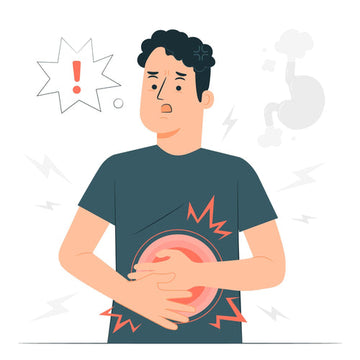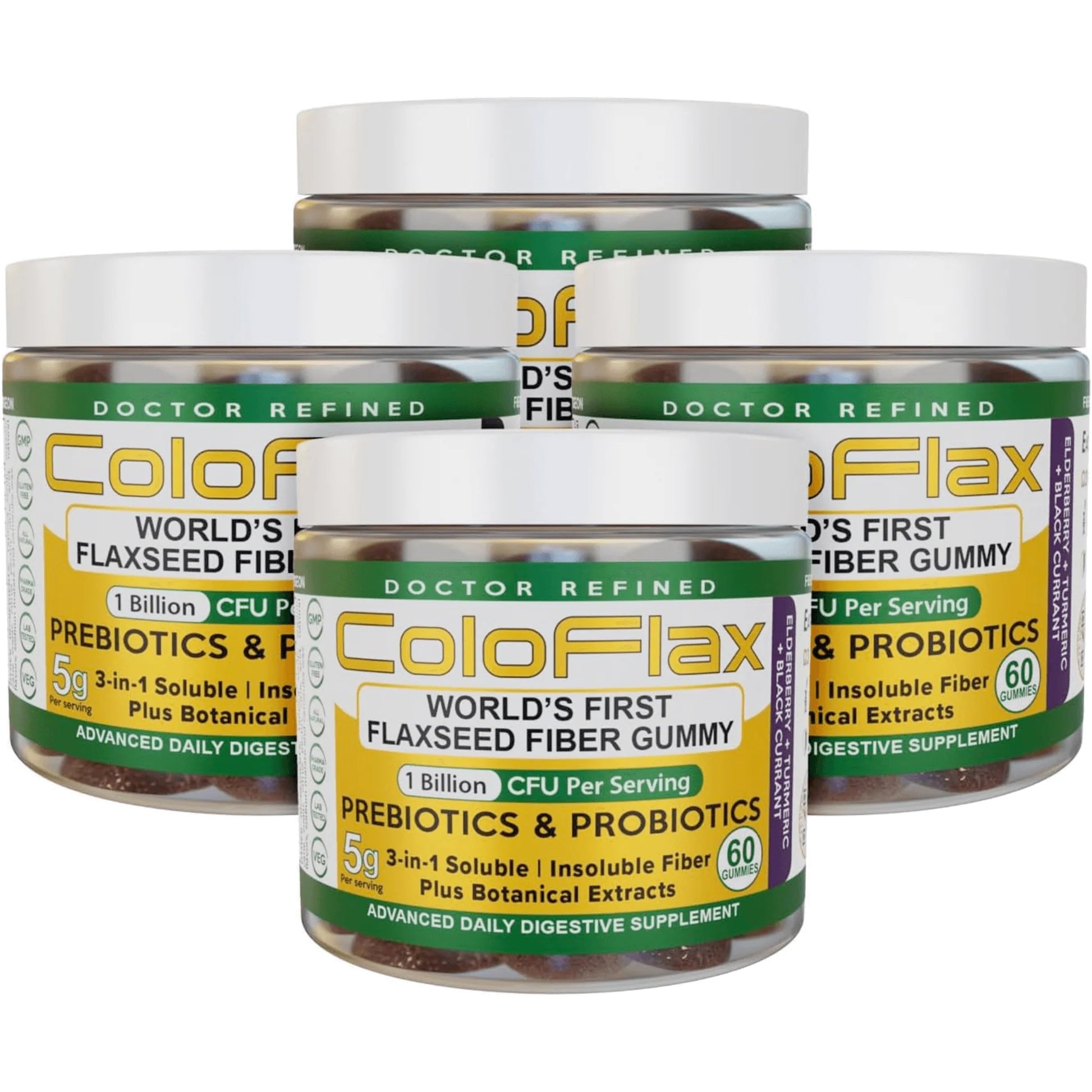The American Heart Association recommends consuming between 25 and 30 grams of fiber a day, a target that few Americans reach. In fact, the majority of Americans barely consume half that amount, thus increasing their risk for everything from constipation to heart disease.(1)(2)
What are the Best Sources of Fiber?
Meat, pasta, bread, dairy—these are some of America’s favorite food groups, but they’re all frighteningly low in fiber.
Just take a look at the fiber content of these popular dishes:
- Big Mac and Large Fries = 9.5g (31.6%*)
- Mac n Cheese = 5g (16.6%)
- Slice of 14” Pizza = 2.5g (8.3%)
- Jambalaya = 1.7g (5.6%)
- Grilled Cheese Sandwich = 1.5g (5%)
- Meatloaf = 0.6g (2%)
*percentage of recommended daily intake based on 30g of fiber.
If you’re thinking that 31.6% is pretty impressive for a fatty, salty, fast food meal, think again. That meal might give you just under a third of your daily fiber intake, but it comes with nearly half of your recommended daily calories.
What’s more, it’s often consumed with a sugary drink, and once you add a couple of morning coffees, an evening glass of wine, and a treat or two, you’re still over 20g short and are edging over 1500 calories.
So, now that we know the bad…what about the good? What are the best sources of fiber and how can you get more of these foods into your diet
Beans and Legumes
When it comes to fiber, you can’t beat beans and legumes. They are packed with the stuff, and a couple of servings is usually enough to meet your daily fiber needs.
Beans and legumes are also high in protein, which can help with satiation, as well as muscle growth and repair.
Here’s a snapshot of what beans and legumes can provide:
- Lentils: Red, green, and French lentils are all full of fiber and protein. They’re also delicious and can be made into soups, curries, and dips. Try some Indian tarka dahl or Greek fakes for a delicious lentil treat.
- Pinto Beans: At 9g per 100g, pinto beans are a fantastic source of fiber. They are also cheap, abundantly available, and delicious. They are the beans used in refried beans, as well as many casseroles.
- Navy Beans: At over 10g per 100g, navy beans have the highest fiber content of all beans. You can add a handful of them to a stew to boost the fiber and protein content.
- Split Peas: These little guys pack one mighty punch. They contain over 8g of fiber per 100g, and they also have a lot of protein. In fact, many vegan proteins are made using pea protein, which comes from split peas. As with lentils, they can be used in curries and dips, such as Greek fava.
- Adzuki Beans: These beans offer something a little different, as they are quite sweet and are used in many Japanese desserts. They have around 7g of fiber per 100g and can be boiled and eaten whole.
- Soybeans, kidney beans, and green peas are also great sources of fiber and protein. Any time that you can add a handful of them to a dish, go for it!
And remember, you don’t need to boil them dry and eat them plain. Just because you’re eating them for health reasons doesn’t mean you can’t add a little salt, butter, or oil.
Root Vegetables
Most vegetables have a high fiber content in relation to their weight and calories. But you’re not a rabbit, and we don’t expect you to meet your daily values by chomping on lettuce.
The best high-fiber vegetables are usually root vegetables—if it grows underground, it’s often high in fiber.
Sweet potatoes, parsnips, beets, pumpkin, and squash are all great sources of fiber. Kale, cabbage, sprouts, and broccoli are very good for you as well. It’s hard to go wrong when it comes to vegetables, and that applies whether you’re eating them raw, flash-cooking them, or boiling them in stews.
Obviously, more nutrients will remain if they are kept in their raw state or cooked lightly, but if you can only eat your vegetables when they have been boiled to mush, go for it. Just refrain from frying them, as the benefits you get from the added fiber and nutrients are likely to be undone by the masses of saturated fat.
If you’re eating potatoes or sweet potatoes, leave the skin on. There are some very beneficial nutrients there, and the skin also contains fiber.
Seeds
Seeds are high in fat, fiber, and nutrients. They are nutritional powerhouses and make for a great addition to soups and salads, as well as snacks that you can enjoy between meals.
Most seeds provide these benefits, including widely available and super-cheap options like sunflower seeds. But some are better than others, and when it comes to fiber content, the following seeds are king:
Flaxseeds
There’s a reason that flaxseed forms the basis of our high-fiber supplement—several reasons, in fact.
A tablespoon of flaxseed contains around 2g of fiber, despite having less than 40 calories. Flax is also rich in antioxidants, magnesium, potassium, calcium, and phosphorus. What’s more, it’s one of the best vegan sources of omega-3 fatty acids, and it’s very easy to add a sprinkle of seeds or powder to your salad or smoothie.
Chia Seeds
If the name sounds familiar, it’s probably because you were one of the millions of Americans who grew up with a Chia Pet.
Chia Pets sprout green “chia hair” thanks to these rapidly growing seeds. But chia seeds are much more than a novelty.
Over the last few years, they have become the superfood of choice for dieters, athletes, bodybuilders, and anyone who appreciates a high-fiber, high-protein, and low-calorie superfood.
A single tablespoon of chia seeds will give you about 4g of fiber while also contributing to your daily needs for protein, iron, calcium, and antioxidants. Chia, like flax, is also a great source of omega-3 fatty acids.
Popcorn
Popcorn is an underappreciated health food. It’s low-calorie and high-fiber, and it’ll also fill you up and keep those hungry hands busy. The issue is that it’s usually loaded with salt, sugar, and butter. If you can avoid those additives, popcorn can be a very healthy and fiber-rich snack.
Bran Cereal and Oatmeal
If you enjoy a bowl of cereal in the morning, give your usual sugary offering a miss and check out some bran cereals. Look at the fiber content and look for something with more than 5g.
Bran cereal has a reputation as something you only eat when you’re constipated and need to stay regular. But it can be a delicious way to start the day, and as it’s rich in fiber, there’s no reason it can’t be eaten every day.
Alternatively, make yourself a bowl of oatmeal.
Oatmeal contains slow-releasing carbs that help to sustain your energy levels throughout the morning. It’s also rich in protein, fiber, and nutrients like iron, copper, magnesium, selenium, and B vitamins.
Fruit
Fruit is rarely given the respect it deserves when it comes to fiber content. It’s dismissed as a high-calorie and inefficient way to meet your requirements. After all, a cup of watermelon will give you give 0.6g of fiber and you’ll also get very little from fruit juices, canned fruit, and even fruits like peaches.
But these are the exception, and there are many high-fiber fruits, as well as many reasons you should be eating them.
Some of the highest-fiber fruits include:
- Passion Fruit (10g of fiber per 100g of fruit): A super sweet and tangy fruit that you can add to yogurts, smoothies, and desserts, or just eat with a spoon.
- Raspberries (7g of fiber per 100g of fruit): You don’t need to do anything with raspberries. They’re delicious straight from the box—just wash and eat.
- Blackberries (7g of fiber per 100g of fruit): A sharper alternative to raspberries that work well in sweet dishes or as a snack.
- Persimmon (4g of fiber per 100g of fruit): A delicious fruit that has a pear-like, brown sugar flavor.
- Pomegranate (4g of fiber per 100g of fruit): Crack open the apple-like shell and enjoy the sweet fruits within. Pomegranates can be messy, but they are also delicious and you get a surprising number of seeds from a single fruit.
- Kiwi (3g of fiber per 100g of fruit): Kiwi is a superfruit with more vitamin C than oranges. It’ll also give you 5g of fiber for just 100 calories of fruit.
Not only are these fruits packed with fiber, but they also contain an assortment of other vitamins and minerals, all of which help you keep your body running optimally. Fruit even contributes to your daily fluid intake, as it’s mostly water.
Just as importantly, fruit makes for a great treat that you can enjoy any time of day. If you find it difficult to meet your fiber needs by loading up on beans, pulses, and vegetables, just snack on a few pieces of fruit throughout the day.
Fruit can replace candy bars between meals and breakfast bars in the morning. It can substitute for sugary pancakes, waffles, and desserts. It’ll fill you up while also sating your sweet tooth.
If you can’t get to the grocery store very often and typically avoid perishable food, look for fruits that stay fresh for many days and even weeks at a time. For instance, as long as you keep them in the fridge, apples and oranges can last for weeks.
You could also invest in a few bags of frozen fruit. Unlike canned fruit, frozen fruit isn’t stripped of its nutrients and coated in syrup. It will lose its integrity, and it lacks the crispness of fresh fruit, but it’s great for use in cooking or for adding to smoothies, pancakes, yogurts, and other dishes.
Summary: The Best High-Fiber Foods
30g might sound like a lot of fiber, but if you eat a balanced diet, you’ll get there very quickly.
A breakfast of bran/oatmeal and fruit, a few servings of vegetables with your meals, a few fruit snacks—that’s all it takes. And that doesn’t mean that you can’t enjoy fast food, candies, and meaty/cheesy meals on occasion.
Think of that 30g target as a loosely defined goal, one that you can meet on occasion and get close to the rest of the time. It shouldn’t be a figure that you obsess over. Consuming 30g of fiber Monday to Friday and then eating 20g on the weekend isn’t going to kill you.
As long as you’re eating well, giving your body what it needs, and staying active, you’ll be fine.
And if you need a little more help meeting your daily fiber needs, COLOFLAX can help!
References
- https://www.ahajournals.org/doi/full/10.1161/01.cir.95.12.2701
- https://www.ncbi.nlm.nih.gov/pmc/articles/PMC6124841/






